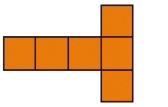
Incorrect. This would form a cube with the T-shape allowing for the top and bottom of the cube to be covered, as well as the 4 sides.
The net of the octahedron is shown below. Which answer choice below states the correct number of faces, edges and vertices for the octahedron?
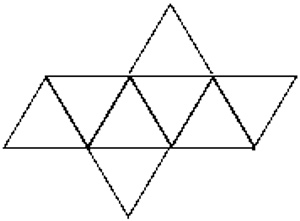
A. 8 vertices, 8 faces, 14 edges
Incorrect. Think of the solid shape that is formed. There will be 4 triangles in each half of the shape, each connected at a vertex, but then there are only the top vertex and bottom vertex left to count.
B. 10 vertices, 10 faces, 18 edges
Incorrect. Count the number of triangles to give you the number of faces.
C. 4 edges, 6 faces, 12 edges
Incorrect. Count the number of triangles above to give you the number of faces. Also, recall Euler’s formula for the relationship of the vertices, edges, and faces.
D. 6 vertices, 8 faces, 12 edges
Correct! You can verify your answer using Euler’s formula, (V + F - E = 2).
Billy constructed the net below. He knows that the net will form a three-dimensional shape, but he is unsure what shape his net would create. The following net would create which shaped named below?
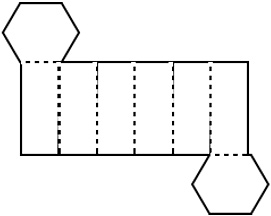
A. Hexagon
Incorrect. You have only identified the base of the figure.
B. Hexagonal Prism
Correct! Since the shape will be 3-dimensional, and has 2 bases with rectangular sides, it will be a prism, named by its base.
C. Tetrahedron
Incorrect. Be sure to look at the shape of the base of the figure that is formed.
D. Hexagonal Pyramid
Incorrect. Although the base is correct, observe shapes in the middle of the net and determine if they would meet at only one vertex or many.
Isaac knows that there are 11 possible ways that the net of a cube can be drawn so that it will fold into a cube. Which of the following nets will not form a cube?
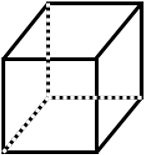
A.

Incorrect. This would form a cube with the T-shape allowing for the top and bottom of the cube to be covered, as well as the 4 sides.
B.
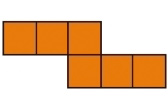
Incorrect. This would fold into a cube if you folded the common edge up at a 90 degree angle, and then folded the remaining sides around.
C.
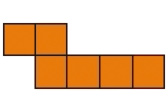 Correct! There would be an overlapping of sides if you folded the common side up at a 90 degree angle.
D.
Correct! There would be an overlapping of sides if you folded the common side up at a 90 degree angle.
D.
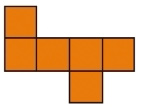 Incorrect. This would form a cube with the single cube on top and the single cube on bottom allowing for the top and bottom of the cube to be covered, as well as the 4 sides.
Incorrect. This would form a cube with the single cube on top and the single cube on bottom allowing for the top and bottom of the cube to be covered, as well as the 4 sides.
Nathan is given the net of a cube. He makes several designs on its faces. Which answer choice represents the cube after it has been folded together?

A.

Correct! The cube has many distinct faces, and once folded, those faces will change in orientation.
B.
 Incorrect. Look at the common edges between the faces of the cube and determine which faces would be touching.
Incorrect. Look at the common edges between the faces of the cube and determine which faces would be touching.
C.
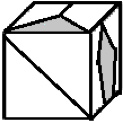 Incorrect. Although the face with the inscribed pentagon does share an edge with the face that has a diagonal, it is not the edge that is shown.
Incorrect. Although the face with the inscribed pentagon does share an edge with the face that has a diagonal, it is not the edge that is shown.
D.
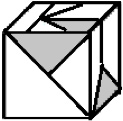 Incorrect. The front face of this cube and the right face of this cube do not share the same edge as the cube we are looking to identify.
Incorrect. The front face of this cube and the right face of this cube do not share the same edge as the cube we are looking to identify.
Nedra constructed the net of a three-dimensional figure. The net she constructed is shown below.
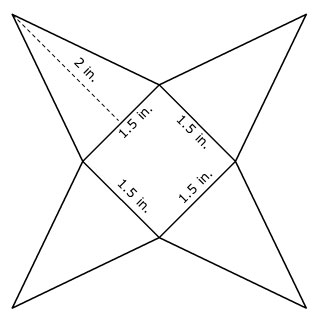
Which of the following statements about the net Nedra constructed is not true?
A. Nedra constructed a net of a square pyramid.
Incorrect. The base of the figure is a quadrilateral with 4 congruent sides, and the lateral faces are all triangles, so this is a square pyramid.
B. The figure represented by the net Nedra constructed has a volume of 4.5 cubic inches.
Correct! The dimension shown on the lateral face is the slant height, which is not the dimension used to determine the volume of a pyramid.
C. Nedra will use 8 1 4 square inches of paper, not counting waste, to construct the net.
Incorrect. The total surface area of the pyramid represented by the net is the amount of paper that Nedra will use to construct the figure.
D. Nedra will use 6 inches of decorative ribbon to completely cover the edges of the base.
Incorrect. The perimeter is the distance around the base of the figure, and the perimeter of the base of this pyramid is 6 inches.